Crimson Peak: An Ecstasy of Gothic Style
 Wednesday, March 11, 2020 at 4:00PM
Wednesday, March 11, 2020 at 4:00PM 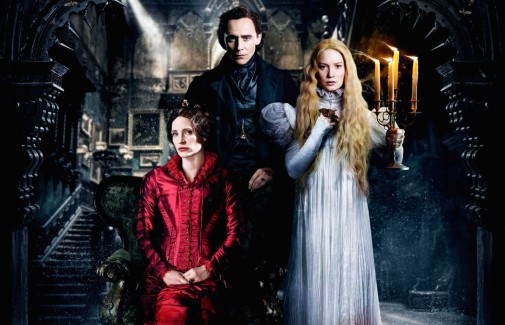
Some films age like fine wine, others like milk. Guillermo del Toro's predecessor to one of the weirdest Best Picture winners ever is closer to grape juice than dairy. If you don't believe it, check out Crimson Peak, which is newly available on HBO Now. The film wasn't particularly well-received upon its 2015 release, but the years have been kind to it, highlighting its best elements while dulling the impact of its less impressive aspects. Its intoxicating visuals are of particular magnificence, resurrecting the iconography of classic Hammer-style horror philtered through the showmanship of Guillermo del Toro's imagination. Some may say this is a case of style over substance, though nothing couldn't be farther from the truth. After all, Crimson Peak is a production where style is substance…
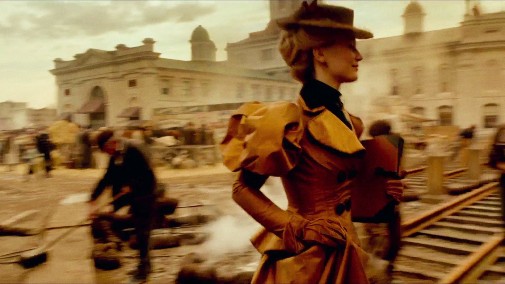
It's been five years but I still can't get over how the awards season treated Crimson Peak. Partially, it's easy to understand the disdain for a film so deliberately clichéd and full of torrid archetypes. This is a love letter to the cinematic nightmares of yore, intentionally artificial, with a narrative that's little else than skeleton upon which the filmmakers build a manifesto on Gothic romance. There's no subtlety here and very little in the ways of shame or good taste. Still, good taste is overrated, especially when it keeps things like Thomas E. Sanders' exquisite set design and Kate Hawley's splendid costumes from being justly rewarded. To say nothing of Fernando Velázquez's luxuriating score, Dan Laustsen's cinematography or the makeup and effects work.

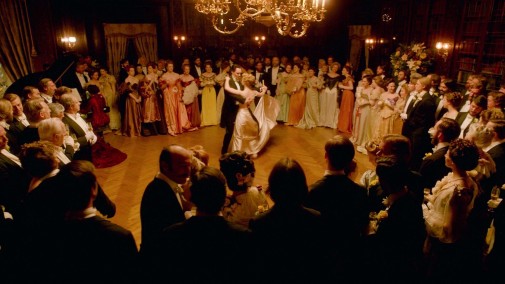
From minute one, Crimson Peak announces itself as a feast for the senses above all else. The production logos appear bathed in sanguine red while the first images of the film proper are snow-covered, cold and deadly. These sorts of contrasts are commonplace for this flick, so carefully designed in games of overt symbolism and chromatic antagonisms. Just look at how del Toro compares the Old World and the New, starting this haunted house tale with a visit to turn-of-century Buffalo, New York. That American metropolis is painted in shades of ochre and rust, a golden promise of prosperity that couldn't be more different than the Europe of squalid derelicts the story presents as it unfolds.
In this land of hope, the camera finds an aspiring writer and modern woman. She's Edith Cushing and she's played by Mia Wasikowska made to look like a Millais portrait come to life. Like an icon of wealth and fertility, Edith's covered in yellow silks and industrially made silk, flowery motifs and the lines of up-do-to-date fashions. Character and place are in perfect harmony, she belongs to Buffalo and its rectilinear architecture, gilded ornaments, and glossy wallpaper. Hers is a world of splendor, ready to be invaded by two specters in dark clothing, their style a beacon of old-moneyed misery, worn velvet and long silk trains with frayed hems.
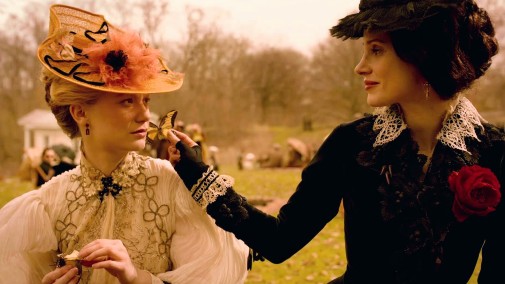
They are Thomas and Lucille Sharpe, aristocratic siblings played with arch perfection by Tom Hiddleston and a steely Jessica Chastain. Before we even see their haunted abode, the costumes of Kate Hawley bring their land to the salons of American high society. Lucille, in particular, dresses in clothes 20 years out-of-fashion but exquisitely made, full of needless seaming that makes her look like a skeletal creature. When we first see her, playing the piano at a lofty dinner party, the train of her bustle gown pools around her like blood, a threat of violence in the form of Victorian couture.
Similarly, the rest of her limited wardrobe is ominous, decorated by garlands of dead leaves made of cord and spiky acorns of wood. At this point, we might not know it, but those ornamental motifs aren't mere symbol, but architectural elements within the gloomy corridors of the Sharpes ancestral home, Allerdale Hall. A mysterious death and a wedding proposal bring Edith to that place, a nightmarish vision of Gothic revivalism and Romantic décor, an impractical beast with rotten foundations, wooden floors bleeding red clay and walls covered in palimpsests of mold.
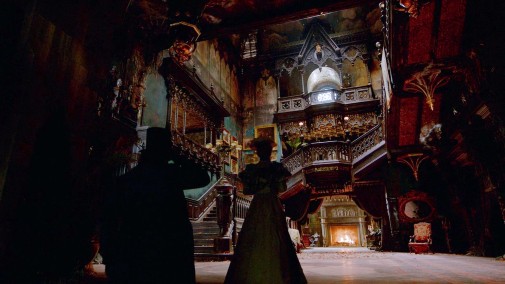
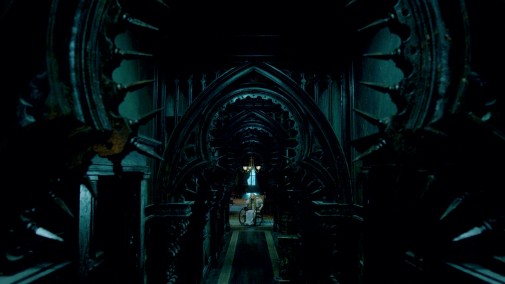
The place is a gigantic set of epic proportions and insane detail, bringing to mind the Ambersons mansion, Tara and other great houses of Old Hollywood. The entire film feels like a throwback to filmmaking mechanisms of yore, from its irises transitions to the glamourous costumes worn by the extras in the American scenes. Above all else, a sense of utter artifice reigns supreme. In a cinematic paradigm where pseudo-realism is the norm, del Toro sacrifices credulity in the name of mood and fun. So much so, that we can practically feel the director's giddiness through the screen.
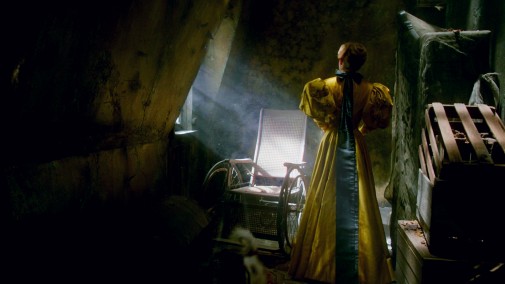
We see it in the expressive sets and poignant costumes, in the way Wasikowska is turned into a yellow canary in a dark coal mine before poison renders her a fragile figure with billowy sleeves fluttering in the wind, like the wings of a dying insect. One of the production's most delightful tricks is its traditional games of scale, which affect both clothing and space. Chairs change sizes throughout the film to highlight power dynamics and Wasikowska's sleeves shrink as if she's wilting. Chastain's long trains, on the other hand, only get bigger.
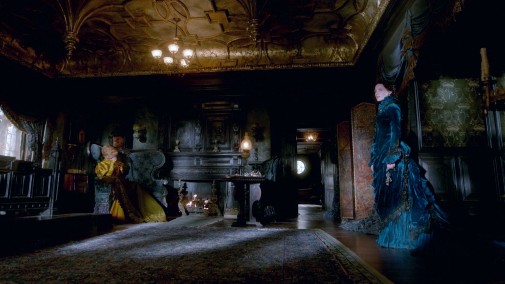
If Edith is life, fertility and wealth, Lucille is death, barren and famine. If we're following the film's delightfully heavy-handed metaphors, this is the story of a butterfly and the black moth that tries to devour it. It's only appropriate that one actress looks like a dying butterfly in its death-throes while the other appears as if she's growing out of the carpets in the old moth-infested manor.

Even the ghosts, one of the aspects of Crimson Peak most mercilessly lambasted by critics, are great. Lost in the limbo between sinewy flesh and immaterial smoke, these apparitions are otherworldly. The CGI-ness works with the film, making them seem like they belong to another plane of existence when in contrast with the physicality of that gigantic set. The spirits shouldn't feel real, so they don't, they feel like bad dreams violating the fabric of reality. Above all else, they're gorgeous in a most unsettling manner, instead of scary they're beguiling.
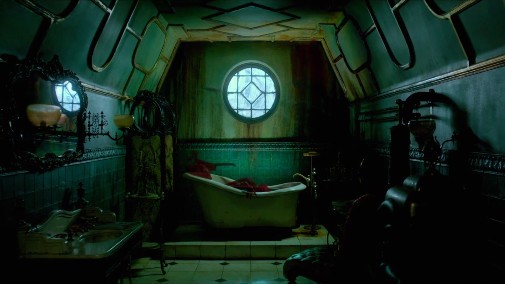
Such is the wonder of Guillermo del Toro's most underrated film, one that I love so much I could write pages and pages about it and its sensorial marvels. Look at the nuptial fashion tinged in the lavender of Victorian mourning, the black ribbon infecting Edith's blouses as her life is infected by the Sharpes, Lucille's nightgown that makes her look like an angel of death or the crimson clay that turns the land into an open sore. Just look at it - it's so beautiful!
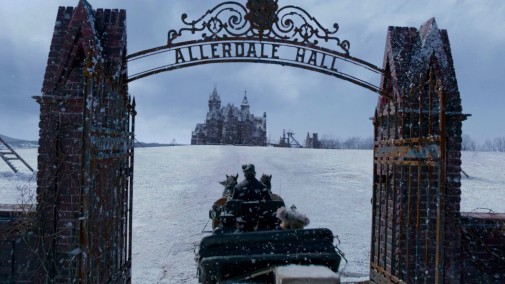



Reader Comments (13)
Never loved the film as a whole, but its production design was among the best of the decade.
A beautiful looking but strangely unsatisfying brew - like so many Del Toro films (Shape of Water leaps instantly to my mind).
I've always thought of this movie as del Toro's own Bram Stoker's Dracula (1992). Loved it then, love it now!
For me, this was one of the best films I had ever seen and I just love the visual elements of the film in its art direction and costume design. Plus, I think it is Guillermo's 2nd best film behind Pan's Labyrinth though I think it showcases the kind of maturity that he is as a filmmaker. It is also a film that gets better with every re-watch while I do think Jessica Chastain was severely robbed of an Oscar nod for Best Supporting Actress. She is intense and I love her performance in that film.
Jessica Chastain is so bad in this movie. Totally miscast.
Should have been nominated (and probably won) for Costume Design.
I love the look of this gorgeous movie but the script goes crazy at the end- I do wish that Del Toro would make a Poe film- now that would be perfect of combination of director and material
WTF? Jessica Chastain was the best part!
Total camp fun.
Chastain can't do camp as well as I can!
Chastain is so far away from camp in it.
She sucks. Beautiful gowns.
Down with camp-less Chastain!
I am hoping Jessica can incorporate some of the great styles from this film into her look in the new Tammy Faye biopic.
This is one of those movie I wish was better that it is